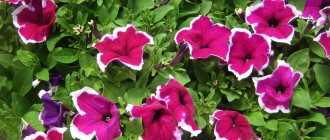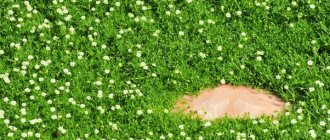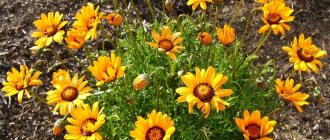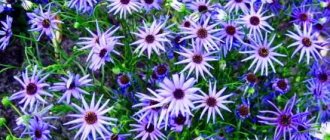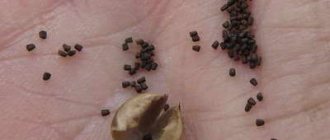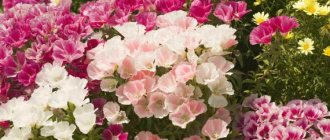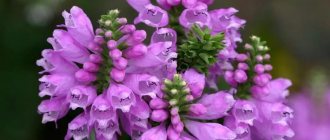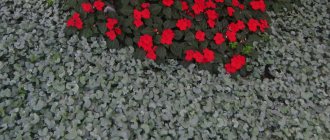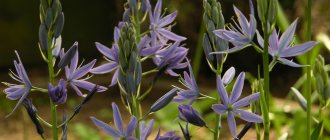Lobelia flowers: origin, description, photo
The genus Lobelia contains more than 300 species of plants in the bellflower family. Wild plants grow in South Africa (Cape region) and are perennial plants; in the latitudes of Russia they are cultivated exclusively as an annual.
Despite its love for warmth, this flower grows well in temperate latitudes. The bushes look like small compact balls and reach a height of 10-40 centimeters. The root system is shallow. Thin, densely leafy shoots do not have a basal rosette. The leaves are elongated, have a serrated edge and are arranged in a spiral on the stem. They barely reach 3-5 centimeters in length and 1.5 cm in width, so during the flowering period they are almost invisible among the lush cloud of blue flowers.
The flowers reach 1.5-2 centimeters in diameter and are located on a short thin stalk. Although the plant belongs to the bellflower family, its flowers have an unusual appearance. They seem to be divided into two parts. The upper one is a lip of 2 petals, the lower part is represented by three wider fused petals. Inside the flower you can find 5 small stamens and a thread-like pistil.
The main species, Lobelia erinus, has blue inflorescences; garden cultivars are represented in a wide range of shades. There are white, light blue, and purple colors. Flowering begins in June and continues until frost.
The fruit of the plant is a multi-seeded capsule equipped with two valves. The seeds are oval, very small with a smooth shiny surface. One gram contains up to 5 thousand of these babies, which remain viable for three to four years.
This is interesting! Varieties with lighter shades of inflorescences have cream-colored seeds.
The stems of the plant contain milky sap, which includes the natural alkaloid lobeline. Due to its property of stimulating the receptors of the respiratory center, it is widely used in medicine to create drugs for asthma.
Brief description of lobelia
Lobelia comes from areas with temperate and subtropical climates and grows wild in North and South America and Africa. The diversity of the flower allows it to be used for various compositions in the garden, on terraces, and balconies. Lobelia, due to its small size and bright color, looks good everywhere - in the open ground and in pots on the terrace.
Lobelia perennial is sometimes grown by gardeners as an annual. Many people like the appearance of this plant; the rounded bush is low-growing, reaching a maximum height of 25-30 cm. There are species that grow up to 1.5 m. The stems of the plants are thin, their branching begins from the base. Whole lanceolate leaves are densely located on the stems. Flowers with a diameter of approximately 2 cm in lobelia are two-lipped, axillary, located on small pedicels.
There are varieties and varieties of lobelia, found in different colors:
- white,
- raspberry,
- pink,
- blue
Photo of the plant
Flowering begins in June and continues until the end of September. The plant leaves many fruits that look like multi-seeded boxes. Seed germination is up to 3 years. Lobelia has been grown as a cultivated plant since 1861. In the conditions of central Russia, it is cultivated mainly as an annual.
Types and varieties
Among the cultivated species, of which there are about 20, there are annual and perennial plants. The greatest value for gardeners is the annual lobelia ernius, also known as blue, border, and hedgehog. It comes in five different forms.
The erect form has column-like bushes reaching a height of 25-30 cm. The ampelous or climbing form has long hanging shoots up to 40 cm. The compact form has spherical bushes with a diameter of 15-20 cm. The spreading form is represented by cascading cultivars with a bush height of up to 20 cm and vines 30 cm long. -40 cm. The dwarf form is distinguished by the small growth of compact bushes, which is 8-12 cm.
Know! Gardeners resort to a simpler classification, dividing all varieties into hanging and bush varieties.
Main bush varieties
Which are popular among gardeners:
- White lady. Graceful spherical bushes 10-15 cm high are covered with a dense white hat.
- Cambridge. Forget-me-not inflorescences abound on spherical bushes with a diameter of 15 cm.
- String of pearls. A variety mixture of low-growing hybrids with different bud colors. Forms a dense carpet up to 10 cm high.
- Crystal Palace. Forms dark blue caps 15 cm high.
- Crystal Palace. The most popular hybrid, characterized by easy cultivation. It has dark blue inflorescences located on bushes up to 20 cm high.
- Royal Palace. A low-growing hybrid with bright crimson buds.
- Emperor Willy. One of the low-growing bush varieties, which, when planted, forms a continuous blue carpet up to 12-15 cm high.
- Riviera. Varietal series represented by an erect form. Its bushes reach a height of 20 cm and have long and abundant flowering. Flowers can be any shade except yellow and red.
- Blue eyes. It is a mixture of early flowering hybrids “Blue Eyes” and “Mrs. Clibran”. It is distinguished by very early flowering, which occurs 3 weeks earlier than other hybrids. Compact bushes, blue inflorescences with a white eye
Hanging varieties (pendula)
- Regatta. Varietal series presented in an ampelous form. It has shoots 30-35 cm long and various shades of inflorescences.
- Niagara. The 30 cm long lashes are densely covered with dark blue buds.
- Cascade. Varietal series of ampelous form. Available in a variety of bud colors.
- Lacemaker. It has white and lilac inflorescences.
- Fountain. A series of ampelous varieties, including a large number of shades.
- Minx. Ampelous hybrid with white flowers.
- Viennese Waltz. A mixture of ampelous hybrids with bright buds of various tones.
Important! Don't fall for the manufacturers' tricks. There are no red, orange or yellow hybrids of Lobelia ernius.
Perennial varieties
Perennials are also common among gardeners. Wild relatives of lobelia purpurea grow in swampy areas of America. The bushes reach a height of up to 1 meter, their crowns are crowned with spike-shaped inflorescences. The flowers are painted in bright scarlet tones, for which they were given a second name - cardinal.
It is interesting that the plant feels great both on land and in water. If you have an artificial pond in your garden, then this bush will be an excellent frame. Landing can also be carried out in shallow water. A feature of the cultivar is increased winter hardiness.
Fiery lobelia stands out among its perennial counterparts with its interesting burgundy leaves. Wild relatives reach a height of 0.8-1 m and have red flowers collected in spikes. “Queen Victoria” is considered one of the most beautiful varieties, the height of which can reach 1.5 m. This perennial overwinters rather poorly, so it is recommended to move it to the basement or organize a winter shelter. The “Russian Princess” variety is beautiful, having bronze leaves and a dark red tint of petals.
Lobelia syphilitica (blue) also has straight stems that are crowned with spikelets of blue flowers. The bushes love high soil moisture and winter well in the presence of snow cover.
Know! Lobelia siphilitica received its name thanks to the Indians. Shamans believed that the plant could cure syphilis.
Lobelia sessile leaves have poisonous juice. It also has tall, erect stems up to 125 cm long. It blooms with blue inflorescences in the second year.
Lobelia Dortmann is an endangered perennial. It grows in bodies of water, producing flower stalks above the surface of the water. It has small blue flowers and is considered an indicator of environmental cleanliness.
Bird home. Herbaceous perennial up to 70 cm high. It has different colors of spike-shaped inflorescences.
Lobelia Gherardi is a subshrub 1.2 m high. It differs from its perennial counterparts in its long period of decorativeness.
Cozy corner. Decorative perennial flower up to half a meter high. It has blue-violet spikelets that bloom in July. It is very demanding when it comes to fertilizing and has high winter hardiness.
Varieties
There are many varieties of lobelia; below is a detailed description of them. The planting scheme and care required for them are the same, the difference lies only in the appearance and size of the bushes.
Beautiful
Lobelia is distinguished by its large bush size up to 90 cm high. The flowers are large, rich, up to 3 cm in diameter. The variety withstands frost and can be grown even in the North.
Red
Red lobelia or "shiny" is famous for its fiery red inflorescences and sometimes reddish foliage. The variety is used by gardeners to create spectacular garden compositions and flower beds. The variety is less frost-resistant than the Beautiful variety, so the bushes require shelter for the winter. They grow up to 80 cm high.
Purple
Purple lobelia has erect stems; the bush grows up to 1 meter high. The variety is widely grown near ponds, reservoirs, on rocky coasts and even in water. The flowers are collected in a spike, purple in color.
Gherardi
The variety is frost-resistant and can survive the winter without shelter even in northern conditions. The inflorescences are rich, purple-violet. The shape resembles spike-shaped inflorescences.
bird home
Lobelia is distinguished by blue or purple flowers and spike-shaped inflorescences. The variety is successfully used to create flower arrangements; it is planted in hanging pots and flowerpots.
Syphilitic
The species is a bush up to 1 meter high. The flowers are dark blue or purple, densely located on the bush. Previously, the variety was considered medicinal; it was used by patients with sexually transmitted pathologies. As medicine developed, the judgment turned out to be false.
Dortman
Lobelia Dortman is the rarest species listed in the Red Book. Inflorescences of different colors, small sizes. The color of the flowers is soft white with a pinkish tint. In nature, they grow on the sandy shores of reservoirs.
Sapphire
Lobelia Sapphire is a hanging plant; in harsh Russian winters, it is considered an annual. Its stem does not stand on its own, but requires a supporting structure or planting a flower in a flowerpot. The plant is widely used to decorate garden plots, garden paths, gazebos, and garden houses. The bush grows up to 20 cm high, covered with bright leaves. The flowers are blue-violet, spike-shaped.
Cascade
Cascade lobelia is an annual plant; the bush grows up to 25 cm high. The leaves are lush, thin stems, white flowers. Their diameter is 1 cm, they are located in the recess of the leaves.
When lobelia blooms, it looks like a snow-white waterfall, cascading down in thin branches.
Emperor Willy
The bushes grow up to 10 cm high, spherical in shape with a densely flowering bush. The stems are thin, fragile, branched. The leaves are oblong, small, dark green. They are densely planted on the stems, making the bush seem dense. The inflorescences are small in size, two-lipped, cornflower blue in color. Their diameter is 2 cm. The variety is famous for its long flowering, which occurs at the beginning of June and ends at the end of September.
See also
Description of types and varieties of celosia, planting and care, growing from seedsRead
Rosamund
The bushes grow up to 15 cm in height, the shoots are decomposed. The leaves are light green, large, the stem is strong. The inflorescences are reddish with a light base in the middle. Their diameter is about 2 cm. The perennial forms a seemingly dense, cascading bush.
Red Volcano
Lobelia grows up to 80 cm tall. The perennial is branched, with strong stems that do not require staking. The flower is fiery red, the inflorescences are dense. Leaves are bronze and orange. This is the most exotic variety of lobelia.
Erinus
The bush is small in size, up to 15 cm high, covered with small flowers of various colors. They can be bluish, pinkish, white. Variegata is famous for its fragile stems and thin, small leaves of emerald color.
Crystal Palace
The shrub is spherical in shape, the flowers are deep blue, up to 2 cm in diameter. They cover the stems, the leaves are almost invisible. The bushes grow up to 30 cm in height.
White Lady
The plant reaches 15 cm in height, the stems are covered with small white flowers 2 cm in diameter. The buds are compact, located in the axils of the leaves. During flowering, bush lobelia looks like a white carpet.
string of pearls
The bushes grow up to 10 cm in height, the leaves are green and lanceolate. The flowers come in a variety of colors; pollen falls in June to late September.
Marquise
The ampelous lobelia Marquise is distinguished by the cascading shape of the shrub, its shoots hanging down. The inflorescences are deep red, up to 2 cm in diameter. The crop blooms all summer.
Riviera
The annual plant is famous for its bright, small flowers of various colors. When flowering, the leaves are almost invisible. The stems are erect, the bushes grow up to 13 cm in height. This is an early flowering variety.
Cambridge Blue Ice
Lobelia is a dense, dense bush, up to 12 cm high. The inflorescences are rich white, reminiscent of a fluffy cloud during pollen. The leaves are emerald green, dense.
Regatta
The plant has dark green leaves and stems, its height is about 20 cm. The flowers come in a variety of colors: white, cornflower blue, lavender. A lot of inflorescences are formed; during flowering, the bush looks densely covered with flowers.
Blue fountain
Climbing lobelia with flowing shoots, grows up to 35 cm high. The flowers are lilac with a crimson tint. The stems and leaves are rich green and strong.
Secrets of growing seedlings
Our southern plant is one of the plants that develops very slowly. About three months pass from sowing to flowering. Although the flower is very unpretentious, the most delicate seedlings require a special approach to cultivation. Let's take a closer look at the little secrets that will help nurture tiny seedlings and get strong plants.
When to sow seeds at home
When growing seedlings, first of all you need to decide on the sowing time. Since the plant has a long growing season, planting work begins in February. However, this growing method is rarely used because it requires additional equipment.
When carrying out early planting work (in January-February), you will need a special phytolamp, which will help provide additional illumination to the entrances. Therefore, gardeners prefer to carry out work in March, when daylight hours are already quite long.
On a note! March shoots develop very quickly and catch up in development with February shoots. They get sick less often and are less prone to stretching due to lack of light.
Some gardeners also practice earlier sowing. This allows you to get flowering bushes by the time they are planted in the flower garden. Warmth comes to central Russia already at the beginning of May, and frosts stop by the middle of the month. To optimally determine the timing, you need to subtract 10 weeks from the moment of planting in open ground. This means that for the middle zone, seedlings need to be sown in early March. If you want to achieve earlier flowering, carry out the work two weeks earlier.
How to choose seeds
When selecting seeds, the purpose of growing the plant should be taken into account. So, if you want to get a bright flower bed or a lushly blooming carpet, give preference to bush varieties. If you want to decorate a gazebo or balcony, choose hanging varieties.
Be sure to pay attention to the manufacturer indicated on the packaging. To avoid possible mis-grading, choose a trusted supplier. Choose packages that have at least one year before the expiration date. The seed material is very fine, so producers often resort to seed granulation. For lobelia, this planting option will be optimal.
On a note! When choosing a variety, give preference not to mixtures of different colors, but to a specific shade. This measure will help you get the intended range in your flower garden.
Preparing seeds for sowing
To avoid possible diseases, the seeds should be disinfected. But the seed material is very small and immersion in a solution of potassium permanganate is impractical. Therefore, experienced gardeners resort to a little trick. They use crystalline fungicides, pouring them directly into the bag of material. Close the bag and shake well. In this case, the crystals evenly powder the material.
Selection of planting container and soil
For sowing seedlings, you can take any container. If you want to avoid the hassle of picking, you need to plant directly in a large container, for example, a flowerpot. You can take small food trays, special mini-greenhouses or peat tablets. It is very convenient to use plastic containers with a transparent lid; they can create a soft and humid microclimate.
A commercial universal soil mixture is suitable as a substrate. If you are used to preparing the soil yourself, you can prepare a mixture that has a neutral environment. A composition of 2 parts garden soil, 2 parts peat, 2 parts humus and 1 part coarse sand is ideal. All ingredients are thoroughly mixed and sifted through a garden sieve.
Know! When planting any crops, add a little vermiculite to the soil mixture. It will make the substrate loose, moisture-absorbing and neutralize excess acidity.
If you use soil from your garden, it should be carefully processed. Spill the soil with a solution of fungicide or potassium permanganate. This measure will help avoid infection of seedlings with fungal diseases. In addition to these processing methods, you can steam the soil in the oven.
Sowing technology
Gardeners use little tricks using different seed starting technologies. For these purposes, you can use sowing in the snow. Tiny dark seeds are clearly visible against a light background. As the snow melts, they gradually sink into the top layer of soil. To use this method, fill the selected container three-quarters full with substrate. Place a layer of snow 2-2.5 cm high on top. Tamp down a little and distribute the material evenly over the surface.
To clearly see the unsown areas of the container, seed material is mixed with sand or fine sawdust. Gently “salt” the substrate and spray it with a spray bottle. You should not use a watering can, as this may wash out the seeds. To ensure good germination, there is no need to embed the material into the soil; it is enough to compact the surface a little.
Cover the container with transparent material and place it on the windowsill. For seedlings to appear, provide a temperature background of at least 18-20 degrees. To avoid harmful stagnation of moisture, you should wipe the container lid from condensation twice a day.
Remember! Seedlings are planted in groups of 5-8 bushes. They dive the entire group and do not separate it when landing.
Growing methods
From seeds
This method of growing has its pros and cons.
The advantages include:
- resistance to diseases and pests;
- the ability to quickly adapt to certain conditions.
The disadvantages of this method are:
- long development of the plant before flowering;
- may not convey varietal characteristics.
How to choose seeds?
The planting material is very fine, so it is easily carried by the wind and the plant often self-sows.
In the case of self-sowing, flowering occurs much later than with organized planting.
To collect seeds:
- The bush is carefully cut and shaken over the paper.
- The collected seeds are placed in a clean and dry container.
- Send it to a dark, dry place and store it there until spring.
Boarding procedure
When growing Lobelia Swallow's Nest with seeds, you need to strictly follow these steps:
- Choose a container that has drainage holes.
- Pour soil into it and compact the top layer.
- Due to the fact that the seeds are very small, they need to be mixed with sand.
- After sowing, spray the soil with a solution of Epin or Zircon. To do this, 1 ml of the drug is diluted in 5 liters of water.
- The seeds do not need to be sprinkled with earth on top, but the entire container is covered with film and placed in a warm place with a temperature of 18-20 degrees.
- Condensation must not be allowed to form. To do this, it is necessary to organize ventilation every day - open the container for half an hour.
- The first shoots will appear in 10-14 days.
- After this, the covering material is removed for 2 hours, increasing the time by 20 minutes every day.
- You need to water the seedlings very carefully. While the sprouts are very small, watering is done using a spray bottle.
- When the first full-fledged leaves appear, a pick is made. To do this, the strongest sprouts are planted in separate containers of 3-5 pieces. For convenience, you can use a teaspoon.
- Containers with sprouts are placed in a cool, bright place with a temperature of 15-18 degrees.
Cuttings
Here, too, you can highlight the pros and cons.
The advantages are:
- rapid growth and flowering of the plant;
- preservation of parental characteristics.
The disadvantages will be:
- stress in the plant from which the cuttings were taken;
- the painstaking process of reproduction.
How to select and prepare cuttings?
- Preparations begin in the fall. It is then that the bushes are dug up, pruned and planted in separate pots.
- Afterwards, the pots with plants are put away in a cool place, where wintering takes place.
- At the end of winter, the plants are taken into cuttings. For cuttings you need to choose the strongest shoots. They need to be broken out at the base and rooted in moist soil.
- Afterwards, containers with cuttings are placed in a warm, well-lit room before planting in open ground.
Procedure
- The dug up bush is transferred to a warm, bright place with a temperature of 5-7 degrees.
- In March, during the growth of young shoots, one of them is torn off, the tips are dipped in water, and then placed in Kornevin’s solution (1 g of product per liter of water).
- After two hours, remove the shoot from the solution and place it in soil or sawdust.
- The pot with planting material is placed in a shaded place and covered with film.
Sowing lobelia seeds on cotton pads
Another common growing method is sowing on cotton pads. To do this, cotton pads should be divided into two parts and placed evenly on the surface of the substrate.
This method is convenient because the seed material is clearly visible on a white background. The surface of the cotton wool is moistened; it is better to use for these purposes not water, but a solution of a growth stimulator, for example, “Epin” or “Zircon”. Place 5-8 seeds on each disk, cover the container with a lid and place on a warm windowsill until shoots appear.
As soon as the plants take root, they are crushed a little with a mixture of earth and sand. Picking and planting in a permanent place is carried out together with a cotton pad. Its soft structure does not at all prevent the roots from growing into the soil layers.
Reproduction methods
From seeds
The advantages of the seed method are as follows:
- the plant is resistant to viruses and diseases;
- young shoots quickly adapt to certain conditions.
Disadvantages of the seed method:
- The plant develops longer before flowering;
- The culture does not always transmit varietal characteristics.
How to choose?
Lobelia planting material is very small . It is easily carried by the wind, so self-seeding of the plant is possible.
In this case, flowering will occur much later than with organized planting. To collect lobelia seeds, you need to carefully cut and shake the bush over a spread newspaper.
Then place the collected material in a clean and dry container . Place it in a dark, dry place in which to store the resulting seeds until spring.
Boarding procedure
If you choose the seed method of propagating Lobelia Swallow's Nest, then you need to adhere to the following plan:
- Fill a container with drainage holes with nutritious soil, while lightly compacting its top layer.
- Since the seeds of the plant are very small, mix them with sand before planting.
- After sowing, irrigate the soil with Epin or Zircon solution (dilute 1 ml of the product in 5 liters of water).
- Do not sprinkle soil on top of the seeds. Cover the container with plastic wrap and place in a warm place where the temperature is 18-20 degrees.
- Remove the film for 30 minutes every day to prevent condensation from developing.
- After 10-14 days, the first shoots appear.
REFERENCE! From this moment on, it is necessary to remove the covering material for 2 hours and increase the time by 20 minutes every day. - Watering seedlings should be extremely careful. At first, the sprouts are very small, so use a spray bottle for irrigation.
- When full-fledged leaves appear, you can proceed to picking. For these purposes, choose the strongest sprouts. Plant them in a pot, 3-5 pieces at a time. It is convenient to pick using a teaspoon. She will cut out a small area of soil with sprouts. Place the collected “portion” in plastic cups, which are placed in a bright and cool place. During this period, keep the plants at a temperature of 15-18 degrees.
Cuttings
Advantages and disadvantages
The advantages of cuttings are as follows:
- the plant grows and blooms quickly;
- all parental characteristics are preserved.
The cutting method also has its disadvantages.:
- the plant from which the cutting was taken is under stress;
- The reproduction process is quite painstaking.
Organization
To propagate a plant by cuttings, it is necessary to start in late autumn before persistent frosts occur:
Dig up the bushes and move them to a bright and heated room, where the temperature is 5-7 degrees Celsius.
- In March, when young shoots are growing, break off one, dip the tip in water, and then immerse in the preparation Kornevin (1 g per 1 liter of water).
- Only after 2 hours place the cuttings in the prepared substrate. You can use steamed sawdust instead.
- The container with planting material must be covered with glass and placed in a slightly shaded place.
Seating
Planting activities should be carried out according to the following plan:
- Prepare a container, lay a layer of expanded clay and a nutrient substrate.
- As soon as the cuttings stop withering, the rooting process has begun, so plant them in prepared containers 2-3 weeks after cutting.
- Thoroughly compact the soil and water it with settled water.
- Place the cuttings in a shaded and cool place.
Growing seedlings in peat tablets
The newest way to grow seedlings is to plant them in peat tablets. Gardeners appreciate the method and use it to grow seedlings of any crop. The method is very convenient.
First, you can make the picking process less stressful. This occurs due to the fact that when picking, the tablet is completely placed in a new container and sprinkled with earth to the required level.
Secondly, there is no need to prepare the soil; the tablets use peat, which is suitable for any type of plant. It is already “filled” with growth stimulants and is completely sterile.
The landing algorithm is as follows:
- Place the washers in a tray and fill them with warm water. At the same time, they will increase in height several times.
- Drain off excess liquid and, if necessary, squeeze out the resulting columns a little.
- To make it easier to distribute the seed over the surface of the tablet, use a moistened toothpick. Dip it into the material and sow it on the surface of the peat.
- Spray the surface a little with a spray bottle and place the peat cylinders in the greenhouse.
Know! You can build a greenhouse yourself. Use a food container with a clear lid or place the peat cylinders in a plastic box and cover with glass.
Description of the variety and its differences from annual
Lobelia grows naturally in countries with subtropical and temperate climates, in Africa, in South and North America.
Outwardly it looks like a bush, short (sometimes up to 225 centimeters in height), but lush. The rhizome of the culture is spherical, fibrous, with branching and thin stems. The leaves are small, lush green, grow abundantly, forming a “cap”. It produces a lot of flowers. They have a bright, memorable color:
- milky white;
- blue;
- blue;
- pink;
- purple;
- violet.
Lobelia blooms from June to September , magnificently and elegantly, since all the buds bloom at the same time.
The fruit is a seed capsule covered with a dense brown shell, in which many small seeds ripen. The shelf life of seeds is 3 years.
Reference! Annual lobelia has a brighter appearance and lush flowering, but the plant is also more delicate and cannot withstand frost. Perennial lobelia is stronger and looks more modest in appearance.
Seedling care, picking
It is very important to organize proper care for delicate shoots. They appear on the surface of the substrate a week after planting. Thin and flimsy seedlings require constant supervision.
Their root system is located near the surface of the soil, so it is important to ensure that it does not dry out, but there is no need to create a swamp, because the moisture-loving “black leg” does not sleep. Its development is promoted by heat and excess moisture. The fungus is capable of mowing down seedlings in a matter of days, ruining your work.
Watering should be done twice a day in measured doses. Use a regular syringe for these purposes and water the plantings from the edge of the box. You can water through a tray.
Do not forget about additional lighting, which is very important for seedlings, otherwise they will stretch out and begin to hurt. Daylight hours should be at least 13-15 hours. You can use both a phytolamp and fluorescent or diode illuminators.
Gradually accustom your sissy to external conditions. Open the greenhouse slightly for 10-15 minutes twice a day, gradually increase the “walk” time. By the time the second leaf appears, the cover can be completely removed.
On a note! If you still do not keep track of the humidity in the container and find mold on the surface of the substrate, carefully remove it with a cotton swab. Water the soil with a fungicide solution.
When the greenery gets stronger and grows to 2-3 cm, you can begin the picking process. Prepare a large container, fill it with the same composition as when planting. Water the seedlings generously and transplant them in small groups into a new pot. It is convenient to use a teaspoon to remove seedlings from the box.
After picking, about a week later, a portion of fertilizer is applied. Use the full complex, adding it with watering. This supply of nutrients will be enough until transplantation to a permanent location.
When the sprouts reach a height of 3-5 cm, they need to be pinched or trimmed. This way, you will achieve increased bushiness of the plant, which will contribute to abundant flowering. When there are 3-4 weeks left before planting in the flower garden, begin to harden the seedlings. Take them out to the open balcony, gradually accustoming them to external conditions. Increase your time outdoors, at first, keeping away from direct light and wind.
Planting in open ground occurs after the threat of the last spring frost has passed. In central Russia this happens in mid-May, in Siberia - in early June.
Know! The southern plant at the seedling stage does not tolerate frost, but an adult bush can easily tolerate autumn frosts down to -7 degrees.
Water the seedlings generously and remove them from the planting container. Plant groups of seedlings at a distance of 10-15 cm from each other. With this planting pattern, a thick carpet is formed. If you use a 25 by 25 cm pattern, you will get individual spherical bushes. Compact the soil around the holes and water thoroughly.
Care
Temperature
If you grow the plant at home, the air temperature should be 20-22 degrees Celsius. Make sure that these indicators do not increase, as this will negatively affect growth and flowering.
Watering
Watering is necessary as the top layer of soil dries . It is important to prevent the soil from drying out and becoming waterlogged. For irrigation, use only settled water at room temperature.
Lighting
When planting lobelia in February, the duration of daylight hours is insufficient for the full development of the crop. Without lighting, seedlings will grow elongated and frail. For additional lighting, you can use fluorescent lamps. It is advisable to keep mature plants on a well-lit windowsill, where there is no direct influence of sunlight.
Topping
As soon as the seedlings take root after picking and grow to 3-4 cm, pinching can be done.
To simplify this procedure, it is necessary to cut off the top of all plants at once . This will make the lobelia bushes more lush and significantly develop the root system.
It is very useful to pinch when several roots are growing in one container. If you carry out the procedure 2-3 times, then from one seedling you can get a large, lush and healthy bush.
Feeding
To fertilize lobelia, it is necessary to use complex mineral fertilizers , which contain nitrogen, calcium and phosphorus. Organic matter, and especially fresh humus, will inhibit lush flowers, promoting the development of lush foliage.
REFERENCE! For the first time, the plant can be fed 2 weeks after planting. The next time to carry out the procedure is during flowering.
Pot
You can grow Lobelia Swallow's Nest in a container. It should be wide and shallow. A flowerpot, flowerpot, pot will do. The selected container must have drainage holes for air exchange .
Lobelia is a universal flower; it can be grown in an apartment, on open loggias and verandas, or planted in the garden, front gardens and flower beds. On our Internet portal you will find articles about the rules for growing other types of this plant, namely the following varieties: Riviera, Emperor Willy, White Lady, Dortman, Rosamund, Erinus, Crystal Palace, Purple, Sapphire.
Lobelia Swallow's Nest is a very beautiful ornamental plant that can be grown both outdoors and indoors. In terms of care, it is not picky, grows quickly and rarely gets sick. But this is provided that you follow all agrotechnical rules and regularly care for flowering bushes.
If you find an error, please select a piece of text and press Ctrl+Enter.
Planting and caring for lobelia in the garden
Unlike tender seedlings, mature seedlings are more unpretentious. Provide them with proper care, and they will respond with lush clouds of flowers.
Choosing a planting site, soil characteristics
For growing in the garden, select moderately lit areas. The southerner will grow in the shade, but the flowering will not be so lush. Due to excessive solar radiation, the soil surface quickly dries out, and the inflorescences fade and change color.
As for the soil, you should pay attention to its fertility. The African guest will happily settle in an area rich in organic matter, only all the growth will go into leaves. In its homeland, it grows in poor soils and blooms beautifully. Sandy loam and loam are suitable for it. They are quite loose and provide good drainage and ventilation of the roots. In the fall, fertilize the soil with sand and vermiculite.
Know! When growing different varieties in one area, in order to preserve varietal characteristics, their isolation from each other is required. All hybrids are cross-pollinated, so the plantation can degenerate in just one season.
When to sow seeds in open ground, seed sowing technology
In warmer regions, sowing directly into open ground is possible. In the south of Russia this can be done as early as mid-April. Granular material is very convenient. Plant at a distance of 15 cm from each other. The southerner will bloom towards the end of July.
In the Middle Zone it is not recommended to carry out such work in open ground. If you don't want to bother with seedlings, you can use a greenhouse. Plant the seedlings in pots and grow them in greenhouse conditions. This should be done as soon as the snow melts, i.e. already in April.
Caring for a plant in open ground
After rooting the seedlings in a permanent place, re-pinch. The guest from the Cape Kingdom has a gentle disposition and will not require your care. All you need to do is remove weeds in a timely manner and monitor watering. It should be done twice a day, especially in hot weather. Once the soil dries out, you are unlikely to revive the moisture-loving flower. Fertilizing is carried out after the end of primary flowering. For these purposes, use potassium-phosphorus complexes. They are aimed at stimulating the development of peduncles.
Important! Completely eliminate nitrogen fertilizing; it stimulates the growth of abundant foliage, but slows down the growth of flower stalks.
One of the most important aspects of care is pruning. After the first wave of flowering, the branches are pruned, leaving shoots 5-6 cm long. This stimulates new tillering and the reappearance of flower stalks.
Growing lobelia "Swallow's Nest" from seeds
They prepare and sow the seeds at the usual time for the plant, the process of growing seedlings is also standard. An important point is that if you need to grow exclusively purple flowers, for example, for an already planned composition, then it is better to buy seeds from reliable producers. From seeds collected independently you can get white, pink-blue or light lilac inflorescences.
Dried seeds are immediately sown in the soil, while regular seeds are first disinfected and calcined. Unlike many other varieties, lobelia “Swallow’s Nest” tolerates picking well; the grains are first sown in wide bowls. At the stage of 2–4 true leaves, seedlings (2–3 pieces each) are planted in separate containers. You should not place the container with the crops in a dark place; the flower hatches well only in intense lighting.
When to sow seeds in Siberia
The Siberian region is characterized by a sharply continental climate. Warmth comes here late, and frosts linger until early June. The length of the March daylight hours may not be sufficient for good development of seedlings. To determine the sowing time for the Siberian region, you need to take the beginning of June as the starting point. Subtract 10 weeks from it, and you will find out that the work needs to be carried out at the end of March or beginning of April. If you want to admire the earlier flowering of the African guest, carry out the work in early March.
How to plant lobelia
Perennial lobelia is grown using seeds. Seeds are planted at the end of February - at the beginning of March in a greenhouse or greenhouse. By this time, the sun's rays will already begin to break through, so the plant will not need to be illuminated.
Seeds are planted in a low and wide container. This plant has very small seeds. Seed germination lasts for 3-4 years. They are sown on the surface without covering them with soil. For even distribution, seeds can be mixed with sand.
There is also this method: the soil is sprinkled with a thin layer of snow, then planting material is laid on top of it. Such measures are carried out in order to prevent the thickening of plantings.
The process of sowing seeds and picking seedlings can be seen in more detail in these videos:
After planting the seeds, the procedure for spraying them with a weak solution of potassium permanganate follows. This eliminates the risk of seedlings becoming infected with blackleg disease.
Subsequent care of crops consists of proper watering, which is carried out through a tray or by spraying from a spray bottle. After sowing, planting is covered with transparent film or glass. The shelter is wiped and turned over every day, thus ventilating the seedlings.
Pests and diseases
Unlike flimsy seedlings, the grown-up inhabitants of the garden are quite capable of taking care of themselves. Not many pests and diseases can destroy an African woman:
- Slugs. The only ones that can cause trouble are shellless snails. They reproduce very quickly and go out to fish only at night. During the day, the pest sits out in shaded areas of the garden. When slugs are detected, the easiest way to scare them away is using traditional methods. The pest cannot tolerate calcium and copper. Liming the soil will protect the greenery from attacks. The smell of bleach is also unpleasant for slugs, so pour “White” into small containers and place them in the root zone.
- Aphid. She attacks the southerner only if there are anthills in the area. Ants breed colonies of aphids and feed on their sweet secretions. It is not difficult to defeat an aphid colony; just spray the greens with a solution of laundry soap and its death is guaranteed. And to prevent a new attack from happening, find the anthill and remove the pests from the garden. Special medications will help with this.
- Spider mite. The insect bites into leaves and stems and sucks out cell juices. The attack can be recognized by the appearance of the finest threads of cobwebs; the leaves curl, turn yellow and wither. Among the folk methods of struggle are infusions of garlic, dandelion, hot pepper, and tobacco. If after treatment the tick appears again among the leaves, resort to treatment with acaricidal preparations. The main pathogens of diseases are fungi. Their mycelia actively grow over the surface of the bush, causing spots of various colors and configurations to appear. If measures are not taken in time, your ward will wither and lose its decorative appearance.
- Powdery mildew, rust, blackleg and various types of rot are quite easy to prevent - you need to maintain moderate watering. If signs of disease are detected, the affected areas of the bush are removed and treated with fungicides.
- Mosaic is a viral disease that is transmitted through soil and water. Characterized by the appearance of characteristic spots with angular edges. They can be yellow, orange, brown. So far, no methods have been invented to combat the virus, so affected specimens should be immediately removed and burned.
Important! Treating the seed and substrate will protect your seedlings from most diseases.
Lobelia climbing: further care and fertilization
Flower culture is not particularly demanding on the soil. Loves loams with neutral acidity. On oily soils and with abundant fertilizer, lobelia blooms worse, growing abundantly with greenery. The main thing is that the soil must be air and water permeable. If lobelias are growing in pots or hanging containers, a good drainage layer is needed. If there are no plans to grow the plant by self-sowing, after the end of color, the boxes with seeds will need to be collected from the site.
Attention! By growing the plant in winter not on the plot, but on the windowsill, you can make it bloom all year round.
This will give you the opportunity to observe bright flowers not only in photographs, but also live.
Important:
- In winter, the plant also requires care - despite the fact that many varieties are resistant to low temperatures, in winter it is correct to cover it with a dense layer of fallen leaves.
- You need to cut off the stem part in advance, leaving an end 20-30 mm high above the ground. Fertilizer application is also important.
- Any complex mineral composition can be used as fertilizers.
The flower crop blooms throughout the summer, and by cutting or removing inflorescences that have bloomed in the autumn. Flowering is most luxuriant in the sun. Fruit: seed capsule with very small seeds. Germination – 3 years after collection. Pests and diseases: not identified.
Lobelia after flowering
As already described above, this perennial is cultivated as an annual plant. Therefore, after wilting, you just need to remove the bushes from the garden bed.
If you want to collect the seeds yourself, wait until they are ripe, cut the bush and shake it over a sheet of newspaper. The collected material can be stored in a paper bag.
Some gardeners grow bushes for several years; before frost sets in, they are pruned and brought indoors. Let it rest in a cool place, and then put it on the window. Fresh shoots form very quickly and flowering begins. Every year the bushes are renewed by cuttings. Layers 5-7 cm long are dipped cut into a growth stimulator and rooted in a mixture of sand and vermiculite. The whole process takes 1-1.5 months, after which the cuttings can be planted in a permanent place.
Planting in a permanent place and care during flowering
In order for the cultivation of perennial lobelia to be successful, it is recommended to plant the plants on loamy or sandy loose soil. It is worth remembering that an excess of fertilizers, and in particular organic matter, prevents the flowering of this plant. Therefore, proper care is important here so as not to harm the flower, while at the same time achieving decorative flowering.
Lobelia is planted in a permanent place after the last frost has passed. This is usually carried out in mid-May. Flowers are planted in groups of 3-4 at a distance of up to 20 cm from each “clump”. By this time, most lobelias will already have flower buds.
If lobelia is given proper care, then it can bloom in June and delight with its colors throughout the summer. In August, lobelia does not bloom so profusely, and in September its flowering ends, but it can be resumed. To do this, you need to cut the flower slightly, loosen the soil well and water the flower generously.
Lobelia will bloom again and delight with its beauty until the end of October, until the first frost occurs. Therefore, growing perennial lobelia is not at all difficult and worthwhile.
You can enjoy the decorative flowering of perennial lobelia all year round if you dig the plant into any flower pot for the winter and bring it indoors.
Marina Makarova
Lobelia "swallow's nest": photo, planting and caring for perennials
Although all varieties of lobelia are perennial, bush varieties cannot survive the winter in open ground. The perennial "Swallow's Nest" winters well in the middle zone, provided that a shelter of mulch or spruce branches is provided. The technology of planting and cultivation does not differ from the cultivation and care of annuals described above.
Lobelia flowers: features
Lobelia is a perennial flower, part of the bellflower family, native to southern Africa. Growing flowers consists of choosing the right place for planting.
Can grow under natural conditions:
- On the rocks;
- In wet soil;
- In temperate subtropics.
Cultivated types of lobelia are actively used in landscape design and look impressive in a flower bed. With its beauty, it provides enormous scope for creative expression - you can find a large number of photographs where the plant is the leader or part of a flower composition.
Lobelia ampelous how to plant and care
The canes of ampelous varieties hang over the edges of the flowerpots, forming delicate floral waterfalls, among which the greenery is almost invisible. Until planting in a permanent place, the cultivation process is the same as for other hybrids. After hardening, the seedlings are planted in flowerpots or flowerpots, having previously provided them with a drainage layer of at least 5 cm.
On a note! Groups of seedlings are planted at a distance of 7-10 cm from each other. So, you will achieve greater decorativeness.
Since the soil in a closed space is quickly depleted, fertilizing should be done once a month. It is preferable to take potash or phosphate fertilizers. Watering and pruning will require special attention from you. Watering should be frequent and the soil should be constantly moist. Bushes are trimmed as often as possible. This allows you to preserve the decorative effect until the frosts.
Lobelia seedling care
After the first shoots appear, after 2 weeks, the shelter is removed for half an hour, then after a few days for an hour or two, adapting the plants to fresh air. As soon as the seedlings get used to room conditions, the glass can be removed altogether.
After 2-3 leaves appear on the plants, they are picked into separate containers. For successful growth, it is recommended to plant seedlings in light and loose soil. The procedure for picking lobelia is a painstaking task. Plants are planted using tweezers. Therefore, if 2-3 plants end up in one pot together, it’s okay.
Further care of plants after picking is to ensure good lighting and a stable temperature within 15 degrees. Watering should be moderate so as not to damage the thin and fragile stems of plants.
If everything is done correctly, immediately after diving, the seedlings begin to actively develop. To get stronger and more lush flower seedlings, pinch them out after 3 weeks. It is especially important to carry out this procedure for plants that are actively growing. During this period, plants will require timely and competent care.
Lobelia in landscape design, combination with other plants
The African guest was highly appreciated by the landscape designers. They noted the high decorativeness of the spherical bushes and flowering carpets of the Cape Guest. It is used as a border and ground cover plant. The southerner will be an excellent filling for a rabatka or complement the edges of a mixborder.
Lush balls also look good on alpine slides. The edges of artificial reservoirs are decorated with tall perennials. They will also serve as an excellent background for any type of flower bed.
Ampelous hybrids are used to decorate gazebos, terraces, and balconies. More and more often you can find them in the company of petunias in flowerpots on city streets.
Alyssums will be excellent neighbors for this exotic plant. The combination of white and blue colors has become a classic. Marigolds, salvia, pansies, petunias, and fuchsias harmonize well with the inhabitants of the Cape Kingdom. A background of tall nymphs, echinacea and zinnia will highlight the delicate clouds.
Forum, reviews
Experienced gardeners are happy to share their experiences in growing various crops. They did not ignore our African guest:
– Inna recommends mixing the substrate for the flowerpot with hydrogel when planting hanging varieties. This allows you to retain life-giving moisture.
– Valentina carried out sowing in tea bags. The result was no worse than when grown in peat tablets. To do this, the two-chamber bags are cut into two parts, and the soil mixture is poured inside. There is no need to remove the tea; it serves as drainage and disinfects the soil.
– Love was disappointed by colored hybrids. While the blue Erniuses were pleased with their abundant and long-lasting flowering, the multi-colored varieties were very sparse.
– Anna takes care of her seedlings; every year she trims them and cultivates them in her apartment. In winter, you can admire the lush blue clouds on the windowsill. She notes that without additional lighting it is impossible to achieve such a result.
Once you have grown lobelia, planting and caring for it, which has some peculiarities, you will admire summer photos and want to decorate your garden with clouds again.

